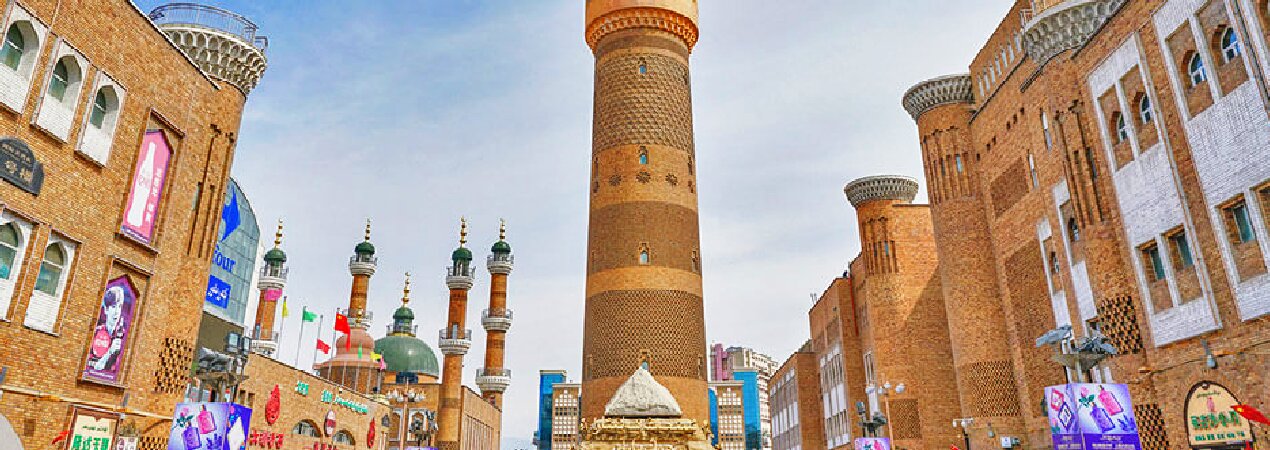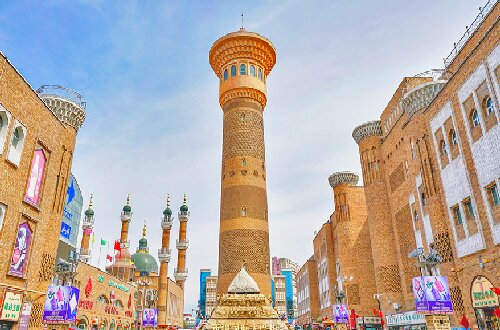Xinjiang International Grand Bazaar

Xinjiang International Grand Bazaar has a total area of 100,000 square meters and is a famous landmark in Urumqi. The Grand Bazaar has more than 3,000 shops, integrating characteristic architecture, folk customs, local delicacies, intangible cultural heritage, folk songs and dances.
- Chinese name: 新疆国际大巴扎 Xīn Jiāng Guó Jì Dà Bā Zhā
- Suggested time: Half a day to a full day
- Ticket: Free
- Open hours: Generally 10:00 - 24:00. But note that during festivals or special events, the hours might be adjusted, so it's advisable to check in advance.
- The best time to visit: All year around
- Address: No. 510, Jiefang South Road, Tianshan District, Urumqi City, Xinjiang Uygur Autonomous Region, China
- How to get there: You can take Line 1 and get off at Erdaoqiao Station, then walk a short distance to reach the bazaar.
Highlights of Xinjiang International Grand Bazaar
Silk Road Observation Tower
 Silk Road Observation Tower
Silk Road Observation TowerThe Silk Road Observation Tower, which is 80 meters high, is one of the landmark buildings in Urumqi. It integrates the column styles of ancient buildings from ancient Egypt, Rome, and Babylon. The first floor of the observation tower serves as an observation deck, and the second floor is the Pailek Bar. The walls of the second floor display landscape pictures and texts of "Top Ten Mysteries of Xinjiang" and pictures and texts introducing the customs of various ethnic minorities in Xinjiang. Going up to the sixth floor, you will find a circular corridor, where the famous Kizil Thousand Buddha Cave murals are reproduced on the walls. For 30 yuan, you can climb the observation tower to see the neon splendor in the southern part of Urumqi.
Grand Bazaar Pedestrian Street
The Xinjiang International Grand Bazaar Pedestrian Street is about 800 meters long and takes the shape of a "T". It is divided into three areas: Area A, mainly focusing on intangible cultural heritage and creative leisure; Area B, mainly featuring characteristic cultural tourism products; and Area C, mainly specializing in Xinjiang characteristic catering and food. In the intangible cultural heritage project block of the Grand Bazaar Pedestrian Street, there are many merchants engaged in inheriting intangible cultural heritage projects, such as folk musical instruments, paper-cutting, dough sculptures, earthenware, and clothing craftsmanship. You can enjoy the tour and experience the intangible cultural heritage and its skills.
Banquet Art Grand Theater
The Banquet Art Grand Theater of Xinjiang International Grand Bazaar is one of the largest and most professional Xinjiang Islamic song and dance theaters in Urumqi, which inherits Xinjiang's thousand-year-old history. It is located in Building 4, with an area of 8,000 square meters, and can accommodate 1,000 people for dining or watching performances. The art troupe presents the large-scale song and dance show "Silk Road • Millennium Impression".
Crafted by top art masters, "Silk Road • Millennium Impression" is regarded as a treasure in the art field of Xinjiang International Grand Bazaar and even the entire Xinjiang. This classic of ethnic song and dance culture showcases the charm of Xinjiang's diverse cultures through superb performances, winning praise from tourists.
Afanti Hotan Barbecue Paradise
 Xinjiang Barbecue
Xinjiang BarbecueAfanti Hotan Barbecue Paradise is a featured catering and entertainment venue centered around the national intangible cultural heritage folk literature "Stories of Afanti". Integrating characteristic shopping, intangible cultural heritage cultural and creative gourmet foods, and leisure performances, it is filled with "Afanti" elements everywhere. Tourists can enjoy Xinjiang's original immersive play "Afanti" here. Among the recommended dishes are crispy baked buns, skewered lamb chops cooked in a naan pit, Uzbek black pilaf, and Nura fried camel milk.
Educational Value
The architectural design of the Grand Bazaar integrates elements such as Islamic arches, Uyghur-style colored paintings, and Central Plains-style columns. Its spatial layout reflects the functional integration of traditional marketplaces and modern commercial complexes, making it a teaching case for architecture and urban planning to explore strategies for balancing cultural heritage protection and modern urban development.
Activities to do at Xinjiang International Grand Bazaar
Participate in mulberry paper making: Learn to use mulberry bark as raw material, go through processes such as soaking, steaming, pulping, and paper-making, and handcraft a piece of mulberry paper with plant fiber texture to understand the wisdom of ancient papermaking techniques.
Experience Uyghur pottery firing: Under the guidance of inheritors of intangible cultural heritage, shape clay on a potter's wheel, draw patterns, and fire your own pottery.
Exploration of architectural aesthetics: As a teacher, you can lead students to observe the Islamic arches, stained glass, and dome structures of the Grand Bazaar, analyze the principles of their seismic design and the wisdom of ventilation and lighting, and compare the material differences between traditional Eastern and Western architectures.
Drop us a line and we'll connect you with the top China expert in no time!